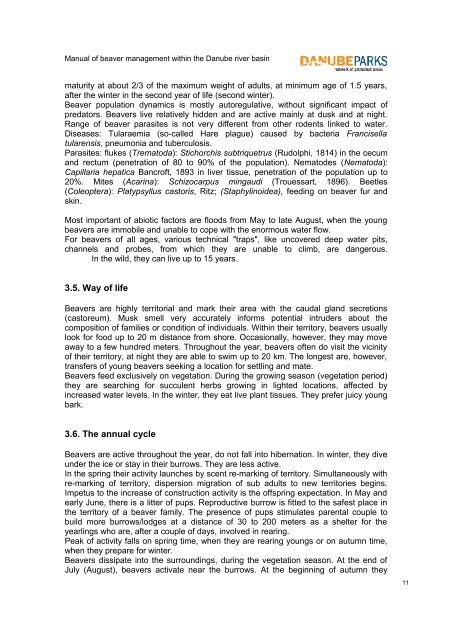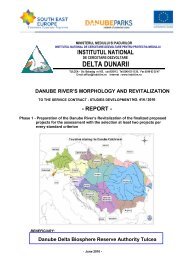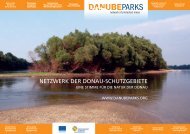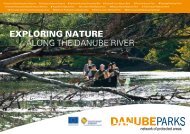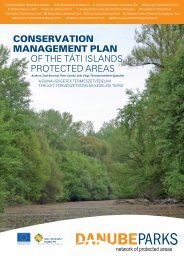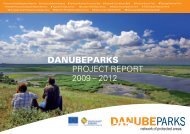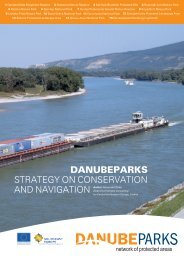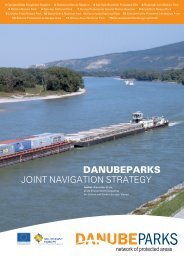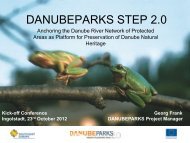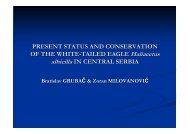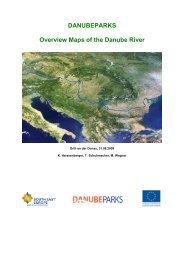Manual of beaver management within the ... - DANUBEPARKS
Manual of beaver management within the ... - DANUBEPARKS
Manual of beaver management within the ... - DANUBEPARKS
- No tags were found...
Create successful ePaper yourself
Turn your PDF publications into a flip-book with our unique Google optimized e-Paper software.
<strong>Manual</strong> <strong>of</strong> <strong>beaver</strong> <strong>management</strong> <strong>within</strong> <strong>the</strong> Danube river basinmaturity at about 2/3 <strong>of</strong> <strong>the</strong> maximum weight <strong>of</strong> adults, at minimum age <strong>of</strong> 1.5 years,after <strong>the</strong> winter in <strong>the</strong> second year <strong>of</strong> life (second winter).Beaver population dynamics is mostly autoregulative, without significant impact <strong>of</strong>predators. Beavers live relatively hidden and are active mainly at dusk and at night.Range <strong>of</strong> <strong>beaver</strong> parasites is not very different from o<strong>the</strong>r rodents linked to water.Diseases: Tularaemia (so-called Hare plague) caused by bacteria Francisellatularensis, pneumonia and tuberculosis.Parasites: flukes (Trematoda): Stichorchis subtriquetrus (Rudolphi, 1814) in <strong>the</strong> cecumand rectum (penetration <strong>of</strong> 80 to 90% <strong>of</strong> <strong>the</strong> population). Nematodes (Nematoda):Capillaria hepatica Bancr<strong>of</strong>t, 1893 in liver tissue, penetration <strong>of</strong> <strong>the</strong> population up to20%. Mites (Acarina): Schizocarpus mingaudi (Trouessart, 1896). Beetles(Coleoptera): Platypsyllus castoris, Ritz; (Staphylinoidea), feeding on <strong>beaver</strong> fur andskin.Most important <strong>of</strong> abiotic factors are floods from May to late August, when <strong>the</strong> young<strong>beaver</strong>s are immobile and unable to cope with <strong>the</strong> enormous water flow.For <strong>beaver</strong>s <strong>of</strong> all ages, various technical "traps", like uncovered deep water pits,channels and probes, from which <strong>the</strong>y are unable to climb, are dangerous.In <strong>the</strong> wild, <strong>the</strong>y can live up to 15 years.3.5. Way <strong>of</strong> lifeBeavers are highly territorial and mark <strong>the</strong>ir area with <strong>the</strong> caudal gland secretions(castoreum). Musk smell very accurately informs potential intruders about <strong>the</strong>composition <strong>of</strong> families or condition <strong>of</strong> individuals. Within <strong>the</strong>ir territory, <strong>beaver</strong>s usuallylook for food up to 20 m distance from shore. Occasionally, however, <strong>the</strong>y may moveaway to a few hundred meters. Throughout <strong>the</strong> year, <strong>beaver</strong>s <strong>of</strong>ten do visit <strong>the</strong> vicinity<strong>of</strong> <strong>the</strong>ir territory, at night <strong>the</strong>y are able to swim up to 20 km. The longest are, however,transfers <strong>of</strong> young <strong>beaver</strong>s seeking a location for settling and mate.Beavers feed exclusively on vegetation. During <strong>the</strong> growing season (vegetation period)<strong>the</strong>y are searching for succulent herbs growing in lighted locations, affected byincreased water levels. In <strong>the</strong> winter, <strong>the</strong>y eat live plant tissues. They prefer juicy youngbark.3.6. The annual cycleBeavers are active throughout <strong>the</strong> year, do not fall into hibernation. In winter, <strong>the</strong>y diveunder <strong>the</strong> ice or stay in <strong>the</strong>ir burrows. They are less active.In <strong>the</strong> spring <strong>the</strong>ir activity launches by scent re-marking <strong>of</strong> territory. Simultaneously withre-marking <strong>of</strong> territory, dispersion migration <strong>of</strong> sub adults to new territories begins.Impetus to <strong>the</strong> increase <strong>of</strong> construction activity is <strong>the</strong> <strong>of</strong>fspring expectation. In May andearly June, <strong>the</strong>re is a litter <strong>of</strong> pups. Reproductive burrow is fitted to <strong>the</strong> safest place in<strong>the</strong> territory <strong>of</strong> a <strong>beaver</strong> family. The presence <strong>of</strong> pups stimulates parental couple tobuild more burrows/lodges at a distance <strong>of</strong> 30 to 200 meters as a shelter for <strong>the</strong>yearlings who are, after a couple <strong>of</strong> days, involved in rearing.Peak <strong>of</strong> activity falls on spring time, when <strong>the</strong>y are rearing youngs or on autumn time,when <strong>the</strong>y prepare for winter.Beavers dissipate into <strong>the</strong> surroundings, during <strong>the</strong> vegetation season. At <strong>the</strong> end <strong>of</strong>July (August), <strong>beaver</strong>s activate near <strong>the</strong> burrows. At <strong>the</strong> beginning <strong>of</strong> autumn <strong>the</strong>y11


